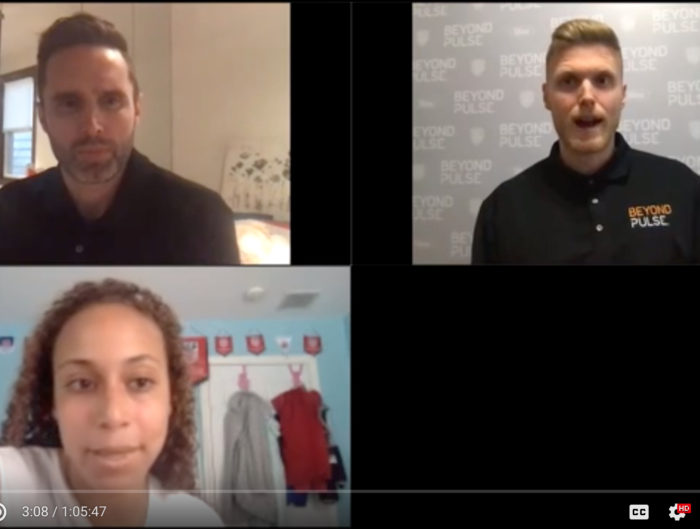In every level of sports, conquering fear isn’t just an option; it’s essential for victory. Alex Honnold, the legendary free solo climber, has mastered this art, transforming fear into triumph. His strategies, revealed in a candid podcast episode with Whoop, are gold mines for athletes and coaches aiming for the top. Fear looms large in the competitive world, but understanding it and harnessing its power can set the stage for unparalleled performance.
From the podcast, Honnold delves into his specific tactics and mindset, each a lesson in courage and precision. These are not just climbing strategies; they’re blueprints for athletes and coaches to revolutionize training and performance with wearable technology. Get ready to turn fear into your secret weapon for peak performance.
Hannolds Highlights for Harnessing Fear:

Preparation and Minimalism:
Alex Honnold’s approach to free solo climbing is underpinned by rigorous, almost obsessive preparation. Every climb is premeditated down to the minutest detail. He doesn’t just scale walls; he masters them beforehand.
For athletes and coaches, this means embracing a lean, focused strategy powered by wearable technology, using data to laser-target training, optimize physical condition, and refine competition strategies. Like Honnold’s precise understanding of every handhold and foothold, wearable tech provides insights that can guide every aspect of preparation. Use wearables not as a catch-all, but as a precision tool to guide and refine your athletic journey.
It’s essential that you’re using a wearable technology that is streamlined, straightforward, and simplified, so that you may strip down to the essentials and paint a clear strategy. This is the heart of preparation and minimalism — where less is indeed more, and attention to detail makes all the difference.
Defining Risk and Consequence:
Honnold’s approach dissects the thin line between risk and consequence. He meticulously differentiates the likelihood of failure (risk) from the potential fallout (consequence). His climbing strategy is to minimize actual risks, making high-consequence climbs feel safe.
Athletes and coaches should adopt this sharp distinction. Use wearables not just as trackers but as risk analyzers: Monitor fatigue, understand stress responses, and evaluate recovery times to sidestep overtraining, undertraining, and injuries.
It’s about smart, data-driven decisions that keep risks low and performance high, regardless of the stakes. Master the balance of risk and consequence with the precision of a climber on a sheer cliff face — that’s where true safety and performance lie.

Mastery and The Feeling of Success:
For Honnold, mastery transcends the physical act of climbing; it’s an immersive experience, a feeling that permeates every stage — the intense preparation, the climb, and the summit. It’s about a deep connection with the journey, not just the destination.
Coaches and athletes, take this to heart: use wearables not just to track player activity, but to tune into your entire athletic arc. Measure and understand every facet — from the sweat of your training, the quality of your rest, to the sharpness of your mental game. Let the data drive not just your readiness, but your confidence and sense of accomplishment.
As you approach each game or competition, let the numbers reassure you: you’re not just going through the motions; you’re living the mastery. Embrace the journey with as much passion as the victory lap, and let every step be a testament to your dedication. This is what it means to truly master your craft.

Playing to Your Strengths:
Honnold’s climbing philosophy zeroes in on leveraging strengths to pull off seemingly impossible climbs. He isn’t just climbing; he’s capitalizing on what he does best.
Coaches and athletes can take this strategy into their arena. Dive into the data from your wearables. Dissect it. Use it to open up dialgoue. Double down on the strengths that your individual players carry. Tailor your training to amplify these strengths. Make them your signature, your secret weapon in competition. It’s not just about being good; it’s about being unbeatable in what you do best. Push your peaks higher and watch as your performance isn’t just enhanced; it’s transformed. This is how you turn strengths into superpowers.

The El Capitan Blueprint:
When training for the El Capitan climb, Honnold didn’t just prepare for a one-off event; he trained extensively, climbing repeatedly to memorize movements and sequences. He didn’t just climb; he embodied the climb, each movement, each sequence etched into muscle and memory.
Coaches and athletes, here’s your blueprint: Treat every match and every game as your El Capitan. Embrace consistent, deliberate practice. Let wearables be your guide — tracking frequency, intensity, duration. Zero in on the specifics of your performance, refine them, and repeat. This isn’t preparation for a single event; it’s the pursuit of excellence, ensuring that when your moment comes, you’re not just ready — you’re in command.

Visualization and Anticipating Every Scenario:
Honnold’s climbs are conquered first in his mind. He visualizes every grip, every potential slip, turning daunting cliffs into familiar terrain.
Coaches and athletes can adopt this mental rigor. Visualize your plays, your races, your victories, and your challenges. Mentally rehearse every scenario, the triumphs and the setbacks. Let this vivid preparation anchor you in the heat of competition.
Using wearables can help to feed your visualization with precision — know your accelerations, your heart rate spikes, your participation scores, your stamina limits, and visualize conquering them too. This isn’t just imagining success; it’s mentally scripting it, detail by detail, until the mind and body are in sync. When you step into the game, you’re not just playing; you’re executing a plan you’ve lived a hundred times over.
Check out this blog on Mental Skills Training for Youth Sports.

Managing Fear with Discipline and Intent:
Honnold’s relationship with fear isn’t about avoidance or complete eradication; it’s about mastery through discipline and intent. He doesn’t just face fear; he systematically dismantles it with each climb.
Coaches and athletes can use discipline as their foundation and intent as their guide. Embrace the biofeedback from wearables to understand your responses to your environment (internally and externally) — then, methodically work to control it.
Develop routines and mental strategies that turn high-pressure moments into familiar ground. Track your progress, refine your techniques, and watch as fear transforms from a roadblock into a stepping stone. This isn’t just managing fear; it’s mastering it, using it as fuel to power through to victory. Be as relentless in your pursuit of mental toughness as you are in physical training, and witness how discipline and intent reshape your performance.
Conquering Fear with Precision
In essence, Alex Honnold’s experience reveals a thoughtful, calculated approach to climbing that’s heavily based on preparation, self-awareness, and mental fortitude. These specific strategies, when adapted and applied using the insights from wearable technology, can significantly enhance an athlete’s training, performance, and overall approach to their sport.

 FRA
FRA
































